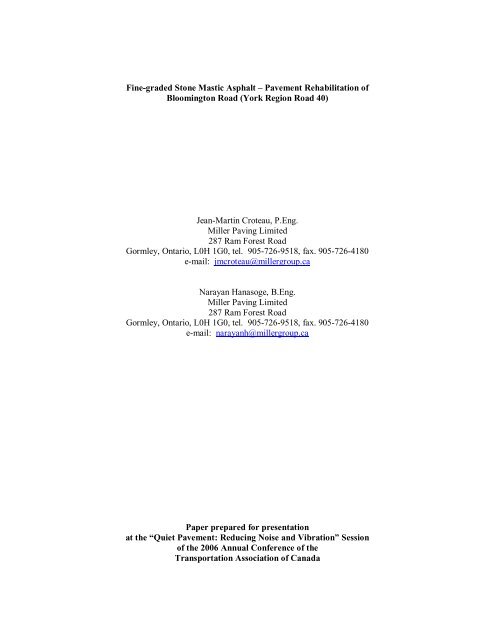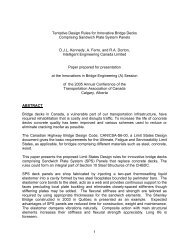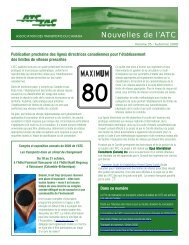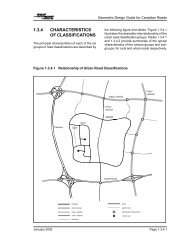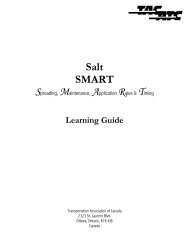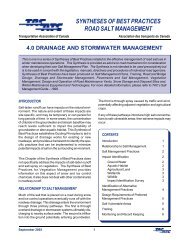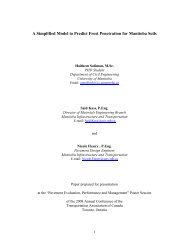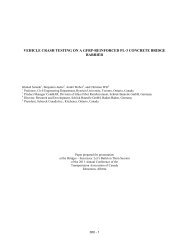Fine-graded Stone Mastic Asphalt – Pavement Rehabilitation of ...
Fine-graded Stone Mastic Asphalt – Pavement Rehabilitation of ...
Fine-graded Stone Mastic Asphalt – Pavement Rehabilitation of ...
Create successful ePaper yourself
Turn your PDF publications into a flip-book with our unique Google optimized e-Paper software.
<strong>Fine</strong>-<strong>graded</strong> <strong>Stone</strong> <strong>Mastic</strong> <strong>Asphalt</strong> <strong>–</strong> <strong>Pavement</strong> <strong>Rehabilitation</strong> <strong>of</strong><br />
Bloomington Road (York Region Road 40)<br />
Jean-Martin Croteau, P.Eng.<br />
Miller Paving Limited<br />
287 Ram Forest Road<br />
Gormley, Ontario, L0H 1G0, tel. 905-726-9518, fax. 905-726-4180<br />
e-mail: jmcroteau@millergroup.ca<br />
Narayan Hanasoge, B.Eng.<br />
Miller Paving Limited<br />
287 Ram Forest Road<br />
Gormley, Ontario, L0H 1G0, tel. 905-726-9518, fax. 905-726-4180<br />
e-mail: narayanh@millergroup.ca<br />
Paper prepared for presentation<br />
at the “Quiet <strong>Pavement</strong>: Reducing Noise and Vibration” Session<br />
<strong>of</strong> the 2006 Annual Conference <strong>of</strong> the<br />
Transportation Association <strong>of</strong> Canada
ABSTRACT<br />
Bloomington Road is a two-lane roadway that carries more than 10,000 AADT with approximately 10 %<br />
heavy commercial vehicle mostly hauling aggregate to the Greater Toronto Area. Prior to rehabilitation,<br />
the pavement was severely oxidized and thermal cracking was extensive. The pavement design included<br />
an in-place recycling technique to mitigate reflective cracking and 100 mm <strong>of</strong> new surfacing HMA. The<br />
partial depth recycling process was selected using a rapid curing recycling system to accelerate the build<br />
up <strong>of</strong> cohesion <strong>of</strong> the recycled material. A heavy duty dense <strong>graded</strong> HMA was selected as a binder course,<br />
while a fine-<strong>graded</strong> SMA was selected as a thin surfacing course. Both HMA mixes were tested for rutting<br />
using a European rut testing device to ensure rut resistance performance. Both mixes were produced using<br />
polymer-modified bitumen to mitigate both thermal cracking and permanent deformation.<br />
The current concept <strong>of</strong> <strong>Stone</strong> <strong>Mastic</strong> <strong>Asphalt</strong> (SMA) or “Splittmasticasphalt” was developed in Germany<br />
in the mid-sixties and introduced in Canada in 1991. <strong>Stone</strong> <strong>Mastic</strong> <strong>Asphalt</strong> is a gap <strong>graded</strong> bituminous<br />
mixture with a high content <strong>of</strong> chippings which constitute an interlocking mineral skeleton to resist<br />
permanent deformation. The space within the chippings skeleton is filled to a large extent by a mortar rich<br />
in bitumen-filler mastic to provide durability. <strong>Fine</strong>-<strong>graded</strong> SMAs is a specific category <strong>of</strong> SMA produced<br />
using single-size chippings no greater than 6.7 mm. The resulting mixture provides an aggressive but fine<br />
macro-texture conducive to surface drainage and good frictional properties. The rolling noise reduction<br />
has been reported to be as much as 3dB(A) compared to dense <strong>graded</strong> surfacing mixes.<br />
This paper presents the Bloomington Rd. project including details related to the roadway characteristics,<br />
the pavement design, the material and process selection and the field construction. Finally, the paper<br />
provides performance information <strong>of</strong> the various techniques with an emphasis on the surface<br />
characteristics <strong>of</strong> fine-<strong>graded</strong> SMA, including skid resistance and noise reduction.
1.0 THE BLOOMINGTON ROAD REHABILITATION PROJECT<br />
Bloomington Road is a two-lane rural roadway located in the heart <strong>of</strong> York Region. Bloomington Road is<br />
a major York Region arterial road that runs between the York-Durham region boundary line and Bathurst<br />
Street. The existing roadway was built to its present standard in 1969.<br />
The 2005 rehabilitation project was located between Hwy 48 and Kennedy Road. The length <strong>of</strong> the project<br />
was the equivalent <strong>of</strong> two concessions, which equates to approximately 4.0 km. The total roadway surface<br />
area to be rehabilitated was 30,000 m 2 . The rehabilitation project did not include the roadway area at the<br />
intersection <strong>of</strong> Bloomington Road and McCowan Road located in the middle <strong>of</strong> the stretch <strong>of</strong> roadway<br />
between Hwy 48 and Kennedy Road. This section <strong>of</strong> Bloomington Road carries more than 10,000 AADT<br />
with approximately 10 % heavy commercial vehicle mostly hauling aggregate to the Greater Toronto<br />
Area. The volume <strong>of</strong> traffic is not only high but it is also considered very aggressive.<br />
Prior to the 2005 roadway rehabilitation, the bituminous surface was severely oxidized and thermal<br />
cracking was extensive (Photo 1). Yet, the longitudinal & transverse pr<strong>of</strong>iles <strong>of</strong> the roadway were still in<br />
relatively good condition and there was no sign <strong>of</strong> major structural failures. The geotechnical consultant<br />
recommendation for the rehabilitation <strong>of</strong> the roadway included an in-place partial depth recycling<br />
technique to mitigate reflective cracking and 100 mm <strong>of</strong> new surfacing HMA.<br />
Photo 1 <strong>–</strong> Roadway condition prior to rehabilitation<br />
The Region elected to select roadway rehabilitation techniques that were compatible with the<br />
recommended rehabilitation strategy proposed by the consultant, but could also provide additional safe<br />
guards to the Region with respect to constructability and long term performance. The recommended inplace<br />
cold recycling process was replaced with a rapid curing partial depth cold recycling process to
accelerate the build up <strong>of</strong> cohesion <strong>of</strong> the recycled material. The traditional binder course HMA was<br />
replaced with a heavy duty dense <strong>graded</strong> HMA specifically design to resist rutting. Finally, the<br />
recommended dense <strong>graded</strong> HMA surfacing was replaced with an SMA for durability and rut resistance<br />
reasons. Both HMA mixes were tested for rutting using a European rut testing device to ensure rut<br />
resistance performance and both mixes were produced using polymer-modified bitumen to mitigate<br />
thermal cracking and permanent deformation.<br />
This paper presents the Bloomington Rd. project including details related to the engineering <strong>of</strong> the<br />
material selected to comply with the geotechnical consultant roadway structural design recommendation.<br />
Performance information <strong>of</strong> the various techniques is provided with additional details on the surface<br />
characteristics <strong>of</strong> fine-<strong>graded</strong> SMA, including skid resistance, surface drainage and noise reduction.<br />
2.0 RAPID CURING PARTIAL DEPTH COLD RECYCLING PROCESS<br />
The process <strong>of</strong> in-place cold recycling <strong>of</strong> bituminous roadway is well established in Canada. Many<br />
Canadian road agencies including York Region use in-place recycling as a standard pavement<br />
rehabilitation method. The main technical benefits <strong>of</strong> in-place recycling relates to the ability <strong>of</strong> the<br />
recycled layer to mitigate reflective cracking, which implicitly provides added life to roadways<br />
rehabilitated using this approach.<br />
The roadway evaluation <strong>of</strong> Bloomington Road quickly led to the selection <strong>of</strong> the partial depth in-place<br />
recycling process. The existing surfacing HMA was severely cracked and oxidized, yet the roadway was<br />
not significantly deformed nor was there any sign <strong>of</strong> major structural weaknesses. Thus, the primary<br />
objective <strong>of</strong> the treatment was to mitigate reflective cracking. The other factor that influenced the<br />
selection <strong>of</strong> the partial depth process vs. the full depth process was the constructability challenges<br />
associated with the rehabilitation <strong>of</strong> Bloomington Road. The one-stage partial depth process was<br />
conducive to minimize the potential traffic disruption.<br />
2.1 Engineering <strong>of</strong> recycled materials<br />
The long term performance <strong>of</strong> any roadway materials is related to its mechanical properties such as:<br />
stiffness, fatigue resistance, reflective cracking mitigation, durability, rutting resistance and thermal<br />
cracking mitigation. Whereas constructability performance <strong>of</strong> recycling work is associated with the:<br />
workability, minimization <strong>of</strong> raveling, ease <strong>of</strong> compaction, increase smoothness, absence <strong>of</strong> post<br />
compaction and rapidity <strong>of</strong> the recycled material to build-up <strong>of</strong> cohesion.<br />
The engineering <strong>of</strong> recycled material is a rational process by which optimal solutions are selected to<br />
maximize the performance <strong>of</strong> the recycling work. The engineering work for the recycling work on<br />
Bloomington Road was carried out in three stages including a detailed analysis <strong>of</strong> the bituminous<br />
aggregate, the selection <strong>of</strong> the recycling system and the laboratory work. Site specific considerations such<br />
as the expected weather during the work and the traffic characteristics were also taken into account.<br />
2.1.1 Bituminous aggregate analysis<br />
Mineral aggregate: The mineral aggregate gradation <strong>of</strong> the reclaimed materials has a direct influence on<br />
the mechanical properties <strong>of</strong> the recycled mixture. Coarse gradations tend to ravel and the build up <strong>of</strong><br />
cohesion is limited, while sandy gradations tend to produce tender mixes <strong>of</strong>ten susceptible to permanent<br />
deformations. The mineral gradation <strong>of</strong> the blend <strong>of</strong> existing bituminous surfacing materials was suitable
for recycling as is, thus, no corrective aggregate needed to be added to the mixture to meet the<br />
requirements for this type <strong>of</strong> recycling work.<br />
Properties <strong>of</strong> aged binder: The properties <strong>of</strong> the aged bitumen contained in the bituminous aggregate were<br />
assessed to determine the type <strong>of</strong> recycling binder needed to optimize the performance <strong>of</strong> the recycling<br />
mixture. The visual inspection <strong>of</strong> the existing roadway clearly indicated extensive oxidation, thus, binder<br />
hardening. The standard penetration test performed at 25°C <strong>of</strong>fers a rapid assessment <strong>of</strong> the binder<br />
hardening and the potential <strong>of</strong> the cold recycled mixture to resist permanent deformation. Furthermore, the<br />
penetration number provides information on the capability <strong>of</strong> the aged binder to contribute to the cohesion<br />
or the recycled mixture. Penetration number <strong>of</strong> the existing surfacing HMA on Bloomington Road was 23,<br />
which was considered relatively hard.<br />
Bitumen aggregate binder content: The binder content is the third important characteristic to assess in the<br />
engineering <strong>of</strong> recycled material. The binder content gives information on the space occupied by the aged<br />
binder within the bitumen aggregate, thus, providing an indication on the amount <strong>of</strong> recycling binder that<br />
may be added to the mixture. The binder content <strong>of</strong> existing surfacing materials on Bloomington Road<br />
before recycling was 5.37 %, which may be considered relatively high and can lead to mixture tenderness.<br />
However, the low penetration number <strong>of</strong> the existing binder provided a safe guard with respect to potential<br />
tenderness <strong>of</strong> the recycled mixture. Thus, it was elected not to use any corrective aggregate, unless the<br />
laboratory mixture properties would be unfavourable.<br />
2.1.2 Selection <strong>of</strong> recycling binder system<br />
Recycling mixtures are produced using a very small amount <strong>of</strong> new recycling binder. Thus, it is<br />
imperative to understand how the aged binder and the recycling binder interact with one another to select<br />
an optimized system. Recycled mixtures may be produced with the addition <strong>of</strong> only 0.8 % added residual<br />
bitumen. Thus, it is accepted that the aged binder contained in the bituminous aggregate contributes to the<br />
build up <strong>of</strong> cohesion <strong>of</strong> the new recycled mixture.<br />
Recycling work using cationic slow setting emulsions is becoming more and more prevalent in Canada.<br />
The coating characteristics <strong>of</strong> cationic slow setting emulsion are significantly different than those <strong>of</strong> the<br />
traditional high float emulsion used for many years in recycling in Ontario. The thickness <strong>of</strong> the coating is<br />
thinner than the coating obtained with high float emulsions, but a larger portion <strong>of</strong> the smaller fraction <strong>of</strong><br />
the bituminous aggregate is coated at an equivalent emulsion dosage. As the added bitumen fluxes through<br />
the aged bitumen, a mortar like paste is created. Cationic emulsions allow the usage <strong>of</strong> a small amount <strong>of</strong><br />
cement or lime to accelerate the build up <strong>of</strong> cohesion <strong>of</strong> the materials recycled. Due to the field conditions<br />
associated with Bloomington Road project, this added feature <strong>of</strong> the cationic emulsion vs. the traditional<br />
high float emulsion turned out to be a deciding factor.<br />
2.1.3 Recycling mixture design procedure<br />
Recycling mixture design procedure is a process by which field conditions are simulated in the laboratory<br />
to evaluate the long term and the constructability performance <strong>of</strong> the recycled mixture. Trial specimens<br />
were produced in the laboratory using a modified version <strong>of</strong> the Marshall method <strong>of</strong> compaction and a<br />
laboratory curing procedure to simulate both the compaction and curing <strong>of</strong> the recycled mixture occurring<br />
in the field. Laboratory testing was performed to determine performance-related parameters that are used<br />
to confirm the adequacy <strong>of</strong> the recycling system and to establish an optimal job-mix formula.
Air voids: The air voids <strong>of</strong> the laboratory specimen are used to assess the ability <strong>of</strong> the recycled mixture to<br />
be compacted and to provide information on the potential risk <strong>of</strong> permanent deformation <strong>of</strong> the recycled<br />
mixture. The target laboratory air voids are between 9 and 11% for the Ontario laboratory curing and<br />
compaction procedure. Voids below 9% are a sign <strong>of</strong> mixture tenderness, while voids above 11% are a<br />
sign <strong>of</strong> mixture harshness. Nonetheless, a harsher mixture was preferred for the Bloomington Road<br />
recycling work due to the heavy traffic and the favouable weather conditions anticipated for the work. The<br />
selected rate <strong>of</strong> recycling binder was 1.7 % <strong>of</strong> a standard CSS-1 emulsion.<br />
Moisture resistance: Air voids <strong>of</strong> recycled mixtures are relatively high compared to dense <strong>graded</strong> hot<br />
bituminous mixture. Furthermore, the coating <strong>of</strong> the recycling binder tends to be selective. Consequently,<br />
recycled mixtures are less cohesive than dense <strong>graded</strong> hot bituminous mixtures. The adhesion <strong>of</strong> the<br />
recycling binder to the bituminous aggregate is critical, particularly at an early age. If adhesion is poor,<br />
rain may have a negative effect on the mixture, which may lead to excessive ravelling. The evaluation <strong>of</strong><br />
the moisture sensitivity <strong>of</strong> the recycled mixture was carried out and the retained stability <strong>of</strong> the mixture<br />
was 76 %, which was above the 70 % target.<br />
2.2 Curing <strong>of</strong> the recycled mat<br />
The build up <strong>of</strong> cohesion <strong>of</strong> recycled mixture occurs over two phases. The initial phase corresponds to the<br />
time period necessary for the recycling binder to form a continuous film <strong>of</strong> bitumen. The end <strong>of</strong> the first<br />
phase also corresponds to the beginning <strong>of</strong> the formation <strong>of</strong> the new effective binder, which is essentially<br />
associated with the second phase <strong>of</strong> the curing. For constructability reasons, the first phase <strong>of</strong> curing in the<br />
case <strong>of</strong> Bloomington needed to be as short as possible.<br />
Bituminous aggregate is a unique material with respect to its reactivity with recycling binders. The aged<br />
bitumen electrically insulates the surface <strong>of</strong> the mineral aggregate, which virtually prevents any type <strong>of</strong><br />
aggregate-binder interaction that may destabilize and break emulsions. Thus, the initial phase <strong>of</strong> build up<br />
<strong>of</strong> cohesion which is associated with the breaking <strong>of</strong> the emulsion becomes highly dependent on the<br />
evacuation <strong>of</strong> water.<br />
The evacuation water and, accordingly, the build up <strong>of</strong> cohesion <strong>of</strong> the recycled mixture are strongly<br />
influenced by the ambient temperature and the atmospheric relative humidity. Warm and dry weather<br />
shortens the first phase <strong>of</strong> curing, while damp and cold weather has the opposite effect. Even though the<br />
recycling work was planned for the warmer months <strong>of</strong> the construction season, a small amount <strong>of</strong> cement<br />
was used as a catalyst to help the breaking <strong>of</strong> a cationic emulsion. Cement is an alkaline product (pH ~12)<br />
and the surface area <strong>of</strong>fered for a small quantity <strong>of</strong> product is extremely high. The alkalinity <strong>of</strong> the cement<br />
destabilizes the acidic emulsions causing them to break even in the presence <strong>of</strong> water, thus, helping the<br />
recycling mixture to build up cohesion rapidly and relatively independently from the evacuation <strong>of</strong> water.<br />
The rate <strong>of</strong> cement added to the recycled mixture was 0.5 %.<br />
2.2 Field work<br />
The field work was carried as planned in the early part <strong>of</strong> June 2005. The bituminous aggregate properties<br />
and the job mix formula are summarized in Table 1 and the recycled mixture properties are included in<br />
Table 2. The work was performed using a conventional recycling train (Photo 2). It should be mentioned<br />
that the recycled mixture was exposed to heavy traffic for a period <strong>of</strong> two months during one <strong>of</strong> the<br />
warmest summer in the region on record. Yet, the recycling work did not show any signs <strong>of</strong> tenderness<br />
leading to post compaction or permanent deformation (Photo 3).
Bituminous aggregate<br />
Binder content 5.37 %<br />
Recovered penetration 23<br />
Passing 4.75 mm sieve 63.4 %<br />
Job Mix Formula<br />
Bituminous aggregate 97.8 %<br />
Cationic emulsion 1.7 %<br />
Cement 0.5 %<br />
Table 1 <strong>–</strong> Bituminous aggregate properties and job mix formula<br />
Recycled mixture properties Results Typical values<br />
Total residual binder content 6.32 % < 6.5 %<br />
Marshall stability - dry 30,350 N<br />
Marshall stability - wet 23,000 N<br />
Retained stability 75.8 % > 70 %<br />
Air voids 10.99 % 9.0 to 11.0 %<br />
Table 2 <strong>–</strong> Recycled mixture properties<br />
Photo 2 <strong>–</strong> Cold In-place recycling train
3.0 RUT RESISTANT BINDER COURSE<br />
Photo 3 <strong>–</strong> Cured cold recycled mat<br />
The second challenge associated with the Bloomington Road project relates to the engineering <strong>of</strong> the<br />
HMA materials and particularly the binder course. Traditional Ontario HMAs are designed using<br />
volumetric parameters related to a certain type <strong>of</strong> compaction energy, Marshall hammer or Superpave<br />
Gyratory Compactor (SGC). The specimens are prepared at a mixing temperature that relates to the field<br />
production and placement temperature. The North American road agencies/industry relies on volumetric<br />
properties <strong>of</strong> mixes to assess the performance <strong>of</strong> HMA mixes. In most cases the volumetric properties will<br />
relate to the field performance, but there are the cases where volumetric properties <strong>of</strong> the mixes were met<br />
and the field performance is inadequate for rutting and permanent deformation. The North American<br />
HMA specifications are performance-related. The performance <strong>of</strong> the bituminous hot mix is related to<br />
factors such as air voids, VMA and others that are indicative <strong>of</strong> the fundamental engineering properties <strong>of</strong><br />
the mixture such as resistance to rutting, fatigue resistance, durability, etc.<br />
In 2001 York Region performed trials at various problematic intersections, where rutting was a recurring<br />
problem. The low speed, high volume <strong>of</strong> heavily loaded trucks turning, acceleration and deceleration as<br />
well as temperature changes during the summer posed a significant challenge to the engineering <strong>of</strong> HMA.<br />
The traditional heavy duty mixes did not perform as expected. The performance-related HMA<br />
specifications used in York Region did not predict rutting at intersections. It was suggested that a<br />
performance-based rut test ought to be considered to assess the long term rut resistance <strong>of</strong> the bituminous<br />
mixtures. The design <strong>of</strong> the mixes was performed using a combination <strong>of</strong> volumetric parameters and the<br />
mixtures were tested using both the “<strong>Asphalt</strong> <strong>Pavement</strong> Analyzer” (APA) and the French wheel tracking<br />
testing apparatus (Photo 4). The experience gained in 2001 lead to an equivalent approach for the 2005<br />
Bloomington Road rehabilitation work.
Photo 4 <strong>–</strong> French wheel tracking testing apparatus<br />
The Bloomington Road work needed specific attention with respect to rutting due to the high volume <strong>of</strong><br />
traffic but also because <strong>of</strong> the type <strong>of</strong> heavy truck using this roadway. The Region requested that<br />
engineering <strong>of</strong> the HMA be performed using the same approach as the 2001 for the intersection work to<br />
confirm the ability <strong>of</strong> the mixture to resist rutting. Rut testing was therefore requested to insure that the<br />
rutting potential <strong>of</strong> the proposed HMA mixture would be mitigate and minimized.<br />
3.1 Engineering <strong>of</strong> the binder course HMA material<br />
The Quebec specification for HMA strongly influenced the development <strong>of</strong> the specifications for the<br />
binder course HMA material in the 2001 intersection contract. All through the 90’ the Ministry <strong>of</strong><br />
Transportation <strong>of</strong> Quebec developed and tested an original and unique HMA mix-design procedure that<br />
combines some <strong>of</strong> the principles related to the Superpave method and the French “Laboratoire Central des<br />
Ponts et Chaussées” (LCPC). The Quebec mixes are closely related to the Superpave mixes with the<br />
exception <strong>of</strong> the binder content which tends to be higher. The Quebec HMA design approach tends to be<br />
more performance-based rather than performance-related.<br />
The Quebec principle <strong>of</strong> fixing the volume <strong>of</strong> binder within the mix and adjusting the voids by optimizing<br />
the gradation <strong>of</strong> the mixture is related to the LCPC method, whereas the volumetric parameters calculation<br />
is directly related to the Superpave method. There are other particularities <strong>of</strong> the Quebec method that are<br />
strongly inspired from the LCPC method. The voids at Ndesign are be related to the voids expected in the<br />
field i.e. 4.0 to 7.0 % not the Superpave single value <strong>of</strong> 4.0 %. Furthermore, Ndesign is related to the<br />
thickness <strong>of</strong> the mat not the traffic. And, whenever the traffic reaches a certain threshold rut testing is<br />
required in the Quebec method, which is a procedure not carried out with the Superpave method.
The principle <strong>of</strong> fixing the volume <strong>of</strong> bitumen in the mixture provides the assurance that it will not be<br />
lean, which indirectly influences the durability <strong>of</strong> the mixture. The volume <strong>of</strong> binder is expressed in<br />
volume <strong>of</strong> effective binder in the Quebec specification and the volume increases whenever the mixture is<br />
placed close to the surface. The volume <strong>of</strong> binder for the York Region contract was not as well defined as<br />
the Quebec specification as it didn’t relate to the effective volume <strong>of</strong> the binder but a minimum percentage<br />
in relation to the aggregate. The percentage <strong>of</strong> bitumen specified in the York region specification was 4.9<br />
%, which is related to a typical binder course used in Quebec.<br />
The voids <strong>of</strong> a mixture compacted at Ndesign provide information on the aggregate packing characteristics<br />
<strong>of</strong> a HMA material and its workability. The design voids requirements are set at the expected field voids<br />
contrary to the Superpave method which set the design voids at 4 % for all the mixture. Whenever the<br />
Ndesign value increases to achieve a given field compaction the harsher the mixture becomes. In the Quebec<br />
method <strong>of</strong> mixture design, the Ndesign value relates to the thickness <strong>of</strong> the mat not the traffic loading. The<br />
principle associated with this relation <strong>of</strong> Ndesign with thickness lies with the cooling rates <strong>of</strong> thin layers vs.<br />
thick layers <strong>of</strong> HMA. On one hand, thin layers <strong>of</strong> HMA tend to cool down faster and the time available to<br />
knit and compact HMA material is shorter, while the opposite applies to thick layers. Hence, the<br />
successful placement and compaction <strong>of</strong> thin HMA is facilitated with workable mixes, while harsher<br />
mixes can still be successfully compacted if they are applied in a thicker lift. The Ndesign value used in the<br />
York Region contract 2001 and 2005 for the binder course was 100 gyrations.<br />
The workability and aggregate packing characteristics <strong>of</strong> a HMA material at the production and placement<br />
temperature <strong>of</strong> 150 ºC may be corrolated to the rutting resistance <strong>of</strong> an HMA material at 60ºC, but not<br />
necessarily in all cases and for any type <strong>of</strong> mixture. As indicated above, the Superpave method is<br />
performance-related with respect to rutting as it assumes that the workability or the harshness <strong>of</strong> HMA at<br />
Photo 5 <strong>–</strong> Four-year old rut resistant HMA placed at Woodbine Ave. and John Street in York Region
150 ºC is representative <strong>of</strong> the rutting resistance <strong>of</strong> the mixture. The LCPC and the Quebec mix-design<br />
methods include a specific rutting test at 60ºC. York Region elected to test rutting in both the 2001/2005<br />
York Region contracts. The usage <strong>of</strong> both laboratory rutting devices, the “<strong>Asphalt</strong> <strong>Pavement</strong> Analyzer”<br />
(APA) and the European Wheel Tracking Test was permitted.<br />
3.2 Base course HMA material selection and mixture design<br />
The primary objective <strong>of</strong> the development <strong>of</strong> the HMA mixture was to address the concern <strong>of</strong> rutting.<br />
Rutting may be related to mechanical deformation (weak or already rutted sub-strata) or due to inadequacy<br />
<strong>of</strong> HMA to meet with the specified requirements (a sub-standard mix) and/or due to the inability <strong>of</strong> the<br />
mix to withstand high temperature changes resulting in high plastic flow allowing the deformation to<br />
occur. The long term performance <strong>of</strong> the pavement is attributed mainly to the Performance Grade <strong>of</strong><br />
<strong>Asphalt</strong> Cement (PGAC) and the mineral aggregate skeleton <strong>of</strong> HMA.<br />
Gradation<br />
Sieve size (mm) JMF Requirement SP-19 Requirements HDBC<br />
26.5 100 100<br />
25.0 100 100<br />
19.0 95 90 - 100 94 - 100<br />
16.0 80 77 - 95<br />
13.2 70 65 - 90<br />
12.5 68 < 90<br />
9.5 59 48 - 78<br />
4.75 47 42 - 52<br />
2.36 41 23 - 49 21 - 54<br />
1.18 30 12 - 49<br />
0.600 21 6 - 38<br />
0.300 9 3 - 22<br />
0.150 4 1 - 9<br />
0.075 3 2 - 8 0 - 6<br />
Bitumen content<br />
Criteria JMF Requirements<br />
PG70-28P 4.9 % > 4.9 %<br />
Volumetric properties<br />
Criteria JMF Requirements<br />
Nini (10 Gyrations) 11.0 % ≥ 11.0 %<br />
Ndes (100 Gyrations) 5.4 % 4.0 to 7.0 %<br />
Nmax (200 Gyrations) 3.6 % ≥ 2.0 %<br />
VMA 15.45 % -<br />
VFA 68.4 % -<br />
Rutting<br />
Criteria JMF Requirements<br />
30,000 cycle @ 60ºC 4.1 % < 10 %<br />
Table 3 <strong>–</strong> Binder course job mix formula details
Binder (PGAC) selection: The selection <strong>of</strong> binder was crucial for the pavement performance. The asphalt<br />
cement binder also plays a significant role in resisting rutting <strong>of</strong> asphalt pavement. The traditional PG58-<br />
28 binder would normally be used in southern Ontario. However, research and experience is now<br />
suggesting that the bitumen grading should be bumped by two grades on the high temperature for<br />
intersection work. The PG70-28 binder was used in the intersection contract <strong>of</strong> 2001 and the performance<br />
after four years is excellent (Photo 5). The polymer modification <strong>of</strong> the binder was also preferred. The<br />
long term performance <strong>of</strong> polymer-modified binder vs. non-polymer-modified binders at an equivalent<br />
“performance grading” is being debated. Based on the 2001 intersection work and the field observations it<br />
was decided to select the PG70-28 polymer-modified binder for the Bloomington Road work.<br />
Aggregate selection: The mineral aggregate skeleton was made up <strong>of</strong> mostly crushed aggregates. A small<br />
amount <strong>of</strong> natural sand was added to the mixture to create the space needed to meet the 4.9 % binder<br />
requirement. In an equivalent Superpave mixture the usage <strong>of</strong> natural sand would not have been permitted.<br />
An equivalent Superpave mixture produced with the same aggregate would have had lower binder content<br />
from 0.4 to 0.6 % compared to this York Region mixture. The rut testing device used to assess the rutting<br />
resistance <strong>of</strong> the mixture provided the assurance that the usage <strong>of</strong> the small amount <strong>of</strong> natural sand would<br />
not be detrimental to the performance <strong>of</strong> the base course mixture.<br />
Mixture design: The mixture was designed using a SGC and the volumetric properties <strong>of</strong> the mixture met<br />
the York Region specified requirements. Rut testing with the designed mixture was conducted using the<br />
French Rut Tester. The job mix formula is summarized in Table 3.<br />
3.3 Field work<br />
The placement <strong>of</strong> the binder course was carried in August 2005. The work was performed using<br />
conventional paving equipment, including a shuttle buggy to avoid mix and temperature segregation.<br />
4.0 SURFACE COURSE <strong>–</strong> FINE-GRADED SMA<br />
The usage <strong>of</strong> SMA type mixtures is still relatively new in Ontario even though one <strong>of</strong> the first North<br />
American SMA trials was placed in Ontario in December 1990. It is a well established technology in<br />
Europe and many <strong>of</strong> the states in the USA. <strong>Stone</strong> <strong>Mastic</strong> <strong>Asphalt</strong> mixes are primarily used for high<br />
volume roads where the requirements for the resistance to rutting are high. It is also well established that<br />
SMAs are more durable than traditional dense-<strong>graded</strong> mixes due to the high binder content.<br />
Region <strong>of</strong> York elected to use a surfacing technology that provided both rutting mitigation and additional<br />
roadway service life. Thus, the selection <strong>of</strong> the SMA technology in lieu <strong>of</strong> the traditional dense-<strong>graded</strong><br />
HMA became a logical choice to achieve the performance objectives set by the Region for the<br />
rehabilitation <strong>of</strong> Bloomington Rd.<br />
<strong>Stone</strong> <strong>Mastic</strong> <strong>Asphalt</strong> mixtures have a high content <strong>of</strong> crushed chippings, which interlock to provide a<br />
strong mineral skeleton. In order to satisfy the SMA requirements the chippings have to meet rigorous<br />
requirements on toughness and shape. The space created within the chipping matrix is filled with a mortar<br />
rich in filler-bitumen mastic. Consequently, SMAs are binder rich mixes which necessitate the usage <strong>of</strong><br />
fibres to avoid drain down <strong>of</strong> the binder during transportation and placement. The uniqueness <strong>of</strong> the SMA<br />
technology used in York Region lies with the fact that the SMA mixture placed on Bloomington Road was<br />
the first fine-<strong>graded</strong> type SMA mixture (Nominal Maximum Aggregate Size < 6.7 mm) placed on a<br />
Canadian roadway.
4.1 Engineering <strong>of</strong> the fine-<strong>graded</strong> SMA material<br />
Similar to the binder course, the development <strong>of</strong> the project specification for the surfacing course was<br />
strongly influenced by the Quebec performance-based approach with respect to rutting and mix field<br />
compaction. Consequently, in addition to the traditional gradation and volumetric criteria traditionally<br />
found in HMA material specification, the York Region project specification included pass/fail<br />
performance-based rut resistance criteria. The gradation specification originally specified in the contract<br />
was based on the Ontario 9.5 mm SMA gradation. The SMA mixture volumetric and rutting performance<br />
requirements are provided in Table 4. As demonstrated hereafter the mix-design work associated with the<br />
SMA mixture lead to the development <strong>of</strong> a fine-<strong>graded</strong> SMA mixture that provides not only excellent rut<br />
resistant and durability performance but also unique surface characteristics.<br />
4.2 Material selection and mixture design<br />
The methodology used to select <strong>of</strong> binder for the SMA was identical to the approach used to select the<br />
bitumen for the binder course. The polymer-modified PG 70-28 was selected to produce the SMA. The<br />
aggregate used to produce the SMA came form a meta-gabbro quarry. The Ministry <strong>of</strong> Transportation <strong>of</strong><br />
Ontario has approved the usage <strong>of</strong> that aggregate on all the high volume roads under their jurisdiction. It is<br />
considered a premium aggregate with respect to its physical and shape properties.<br />
The selection <strong>of</strong> the individual aggregates to produce the SMA mixture was a challenge. The Ontario 9.5<br />
mm SMA has a very narrow gradation band and the commercially available aggregates produced in<br />
Ontario are not conducive to meet this gradation band. However, the availability <strong>of</strong> a 6.7 mm single size<br />
Gradation<br />
Sieve size (mm) JMF 9.5 mm SMA 6.7 mm SMA*<br />
12.5 100 100<br />
9.5 100 92 -100 100<br />
6.7 98 90 -100<br />
4.75 78 70 - 76<br />
2.36 33 30 - 35 28 - 38<br />
0.075 11 8 - 12 8 - 12<br />
Bitumen content<br />
Criteria JMF Requirements<br />
PG70-28P 5.8 % -<br />
Volumetric properties<br />
Criteria JMF Requirements<br />
Nini (10 Gyrations) 14.5 % ≥ 11.0 %<br />
Ndes (80 Gyrations) 5.5 % 4.0 to 7.0 %<br />
Nmax (200 Gyrations) 2.4 % ≥ 2.0 %<br />
VMA 17.0 % -<br />
Rutting<br />
Criteria JMF Requirements<br />
1,000 cycle @ 60ºC 4.5 % < 10 %<br />
3,000 cycle @ 60ºC 5.2 % < 20 %<br />
30,000 cycle @ 60ºC 7.3 % -<br />
* Proposed<br />
Table 4 <strong>–</strong> SMA material specifications and job mix formula details
chip provided the opportunity to consider the usage <strong>of</strong> a smaller aggregate for the production <strong>of</strong> the<br />
prescribed SMA without significantly changing the gradation requirement <strong>of</strong> the mixture. Similar to the<br />
base course HMA, the primary objective <strong>of</strong> the development <strong>of</strong> the SMA mixture was to address the<br />
concern <strong>of</strong> rutting. The field experience related to small Nominal Maximum Aggregate Size (NMAS) type<br />
mixture is limited, but the European and the Quebec experience related to rut testing indicates that the size<br />
<strong>of</strong> the NMAS <strong>of</strong> the mixture does not influence the resistance to rutting. Furthermore, regardless <strong>of</strong> the<br />
gradation and the volumetric characteristics <strong>of</strong> the proposed mixture, the rut testing was considered the<br />
fail/pass deciding factor in this case. Therefore, it was determined that the selection <strong>of</strong> a small NMAS<br />
should not be a deciding factor in the development <strong>of</strong> the SMA mixture, which subsequently lead to the<br />
development <strong>of</strong> a fine-<strong>graded</strong> SMA.<br />
The mixture was designed using a Superpave Gyratory Compactor and the volumetric characteristics <strong>of</strong><br />
the mixture are contained in Table 4. The mixture was tested for rutting using a European rut testing<br />
device. The rutting test results are also provided in Table 4. The final gradation <strong>of</strong> the SMA mixture met<br />
the gradation <strong>of</strong> the 9.5 mm gradation band except for divergence <strong>of</strong> 2 points at the 4.75 mm sieve. Since<br />
the divergence from the 9.5mm gradation was minor and all the other mix requirements were met the<br />
Region accepted the submitted fine-<strong>graded</strong> SMA mix-design.<br />
4.3 Field work<br />
The placement <strong>of</strong> the fine-<strong>graded</strong> SMA was carried out in the middle <strong>of</strong> August 2005 right after the<br />
placement <strong>of</strong> the binder course. The placement was performed using conventional paving equipment<br />
including a shuttle buggy to avoid mix and temperature segregation. The compaction was performed as<br />
per the current practice for SMA with the exception that an oscillating type vibratory roller was used<br />
instead <strong>of</strong> a conventional vibratory roller.<br />
4.4 Surface characteristics<br />
The surface characteristics <strong>of</strong> fine-<strong>graded</strong> SMA are excellent considering that the NMAS is only half the<br />
size <strong>of</strong> a conventional surfacing course dense <strong>graded</strong> HMA. Many <strong>of</strong> surface characteristics features<br />
reported in various technical briefs related to this type <strong>of</strong> SMA type mixture were confirmed with the<br />
Bloomington Rd. project.<br />
The excellent surface characteristics <strong>of</strong> the fine-<strong>graded</strong> SMA are related to the unique macro-texture <strong>of</strong> the<br />
mixture. Field measurements have indicated that the macro-texture depth <strong>of</strong> the fine-<strong>graded</strong> SMA is<br />
comparable to the macro-texture <strong>of</strong> a dense-<strong>graded</strong> HMA produced with a NMAS twice the size. The<br />
macro-texture depth was measured using the sand patch method on two sections <strong>of</strong> Bloomington Rd.: the<br />
SMA section and the adjacent dense-<strong>graded</strong> HMA section. The macro-texture depth for both mixtures, the<br />
(6.7 mm NMAS) fine-<strong>graded</strong> SMA and the 13.2 mm NMAS HMA was 0.54 mm. The difference between<br />
the two surface macro-textures is related to the fine cross-section <strong>of</strong> the mixtures macro-texture. The<br />
macro-texture <strong>of</strong> the fine-<strong>graded</strong> SMA has a relatively uniformed depth and the distance between the<br />
peaks is less than 10 mm, while the depth <strong>of</strong> the dense-<strong>graded</strong> HMA is variable and the distance between<br />
the peaks is also variable, <strong>of</strong>ten greater than 10 mm.<br />
The macro-texture <strong>of</strong> the fine-<strong>graded</strong> SMA may be comparable to other SMA type mixture, but the<br />
distance between the peaks and the depth <strong>of</strong> the surface interstice is much smaller than other SMA. This<br />
fine-<strong>graded</strong> but aggressive macro-texture (Photo 6) confers to this type <strong>of</strong> SMA a multitude <strong>of</strong> excellent
Photo 6 <strong>–</strong> <strong>Fine</strong>-<strong>graded</strong> SMA surface texture<br />
surface characteristics as a roadway surfacing system including good surface drainage, reduction <strong>of</strong> glare<br />
at night from reflection <strong>of</strong> lights <strong>of</strong> oncoming vehicles, excellent frictional characteristics and appreciable<br />
reduction in rolling noise.<br />
The surface characteristics <strong>of</strong> porous asphalt mixes (open <strong>graded</strong> mixes) are excellent and generally better<br />
than any low voids mixtures including fine-<strong>graded</strong> SMAs. However, in the Canadian context due to the<br />
extensive and aggressive winter maintenance porous asphalt mixes tend to clog up and ravel at a relatively<br />
young age. Consequently, the durability <strong>of</strong> this type <strong>of</strong> asphalt mix is <strong>of</strong>ten questioned and the usage <strong>of</strong><br />
this type <strong>of</strong> mixture is rare. Even though the surface characteristics <strong>of</strong> fine-<strong>graded</strong> SMA is not as good as<br />
porous asphalt, in the Canadian context this low void type mixture is an excellent compromise between<br />
the traditional large NMAS low void mixes (dense-<strong>graded</strong> mixes and SMA) and the porous asphalt with<br />
respect to surface characteristics.<br />
4.4.1 Skid resistance and surface drainage<br />
The skid resistance was measured using the ASTM Brake Force Trailer procedure. The Skid Number<br />
obtained for the Bloomington Road fine-<strong>graded</strong> SMA is well above the expected minimum for this type <strong>of</strong><br />
roadway after three months <strong>of</strong> service. It is suggested that the fine-<strong>graded</strong> but aggressive macro-texture <strong>of</strong><br />
this type <strong>of</strong> SMA provides additional points <strong>of</strong> contact with the rubber <strong>of</strong> the tire, while evacuating the<br />
surface water efficiently through and within the surface texture <strong>of</strong> the mixture, consequently providing<br />
more friction. The evolution <strong>of</strong> the skid resistance <strong>of</strong> SMA and other dense <strong>graded</strong> mixes is being studied<br />
world wide and the information available on this fine-<strong>graded</strong> SMA is limited, nevertheless the Skid<br />
Number obtained on Bloomington Road is very encouraging.
4.4.2 Rolling noise<br />
Roadway traffic rolling noise is an increasingly important environmental issue in most industrialised<br />
countries. Generally, whenever the speed <strong>of</strong> a vehicle reaches 60 km/hr. the rolling noise becomes primary<br />
source <strong>of</strong> traffic noise. Rolling noise is generated by series <strong>of</strong> phenomena occurring at the tire/roadway<br />
interface. Rolling noise has been extensively researched worldwide and it has been demonstrated there are<br />
techniques available to produce roadway surfacing materials that will mitigate rolling noise without<br />
compromising on safety, durability and cost effectiveness. <strong>Fine</strong>-<strong>graded</strong> SMA surfacing system used on<br />
Bloomington Rd. is considered in many countries as a quiet surfacing system.<br />
4.4.2.1 Rolling noise generation/enhancement mechanisms<br />
At the tire/roadway interface several mechanisms generate energy which eventually radiates as sound<br />
along with other mechanisms that will amplify the sound. The mechanisms that generate energy are:<br />
- tire tread impact with the roadway surface (rubber hammer),<br />
- air pumping at the interface <strong>of</strong> the tire/roadway (clapping hands),<br />
- slip-stick <strong>of</strong> tire tread blocks (athletic shoes on gymnasium floor) and,<br />
- the stick-snap <strong>of</strong> the tread blocks with the roadway (suction cup).<br />
The mechanisms that amplify the sound are numerous and much more complex. As an example, the tire<br />
belt/carcass and side wall vibrations will amplify sound generated mechanically.<br />
4.4.2.2 Mitigation <strong>of</strong> rolling noise<br />
Worldwide experimental findings have demonstrated quieter roadways are obtained whenever the:<br />
- distance between the peaks within the macro-texture is smaller than 10 mm,<br />
- surfacing system is porous,<br />
- surfacing system is elastic, and<br />
- macro-texture is negative rather than positive (Figure 1).<br />
Macro-texture depth (mm)<br />
1.0<br />
0<br />
-1.0<br />
1.0<br />
0<br />
Positive texture<br />
Negative texture<br />
-1.0<br />
0 20 40 60<br />
Distance (mm)<br />
80 120 140<br />
Figure 1- Positive macro-texture vs. negative macro-texture
Short distances between the peaks within the macro-texture and the negative macro-texture reduce the<br />
intensity <strong>of</strong> the tire tread impact/deformation which in turn reduces the tire vibration. This type <strong>of</strong> uniform<br />
and fine-texture (< 10 mm) at the macro-texture level (0.5 to 50 mm) is obtained with the usage <strong>of</strong><br />
surfacing systems produced with single size small NMAS (10 or 6 mm). The negative macro-texture <strong>of</strong><br />
surfacing systems is achieved with the usage <strong>of</strong> smoothing device such a finisher screed.<br />
The porosity <strong>of</strong> the surfacing system reduces the strength <strong>of</strong> the air pumping source <strong>of</strong> rolling noise by<br />
preventing and dissipating the air compression underneath the tire. Porous asphalt surfacing systems have<br />
that capability and they are well known to be quieter roadway surfaces. Unfortunately, as indicated in a<br />
previous section, this type <strong>of</strong> surfacing system tends to not be as durable as the traditional dense-<strong>graded</strong><br />
mixes in the Canadian context and they are now rarely used.<br />
Elastic surfacing systems are produced using recycled rubber. The mechanical elasticity <strong>of</strong> these systems<br />
contributes to reduce the intensity <strong>of</strong> the mechanical sources <strong>of</strong> sound. Rubber modified mixes have been<br />
used on a limited scale for many years. They were originally developed for recycling purposes rather than<br />
noise. Nowadays, many US road agencies are using them for rolling noise abatement in urban settings.<br />
4.4.3 Potential noise abatement <strong>of</strong> fine-<strong>graded</strong> SMA<br />
Low noise surfacing systems are produce with one or a combination <strong>of</strong> the above features. Porous asphalt<br />
mixes (in-place voids 18-25 %) are the quietest systems followed by the fine-<strong>graded</strong>, low voids surfacing<br />
system (in-place voids 7-9 %) and the rubber modification <strong>of</strong> the binder. The gain in noise reduction <strong>of</strong> for<br />
certain type <strong>of</strong> porous asphalt system compared to traditional dense <strong>graded</strong> HMAs has been reported to be<br />
as much as 6 dB(A). The gain for a fine-<strong>graded</strong>, low voids surfacing system may be as much as 3 dB(A).<br />
Noise abatement in the magnitude <strong>of</strong> 3 dB(A) in rolling noise is significant. A reduction <strong>of</strong> 3 dB(A) is<br />
correspond to doubling the distance <strong>of</strong> the noise source or reducing the traffic volume by 50 %. The other<br />
point <strong>of</strong> reference is the traffic speed: noise abatement <strong>of</strong> 3 dB(A) is equivalent to a reduction <strong>of</strong> 25 % <strong>of</strong><br />
the traffic speed.<br />
The fine-<strong>graded</strong> SMA mixture placed on Bloomington Rd. qualifies as a fine-<strong>graded</strong>, low voids surfacing<br />
system. It is suggested that the multiple points <strong>of</strong> contact with the rubber <strong>of</strong> the tire provided by the fine<br />
but aggressive macro-texture and the high surface voids <strong>of</strong> the fine-<strong>graded</strong> SMA are reducing all the<br />
rolling noise mechanisms. Even though the rolling noise was not measured, the field observations over<br />
several months <strong>of</strong> service have clearly indicated that the rolling noise generated by this type <strong>of</strong> surfacing<br />
system is definitely less than that <strong>of</strong> conventional mixes. The rolling noise difference between the two<br />
surfacing system is audible confirming the reported gain in noise reduction for this type <strong>of</strong> surfacing<br />
system.<br />
5.0 SUMMARY<br />
The rehabilitation work undertaken on Bloomington Road in the summer <strong>of</strong> 2005 was performed using a<br />
unique approach. The techniques selected, by their nature and past usage in Ontario, were not new to this<br />
market, but the material design approaches used to develop the recycled mixture and the HMA materials<br />
were and are still not well established in Ontario. In many respect, the Bloomington Road rehabilitation<br />
project has allowed York Region to explore a roadway rehabilitation approach that may be qualified as<br />
performance-based rather than performance-related.
Photo 7 <strong>–</strong> Completed roadway rehabilitation work<br />
The development <strong>of</strong> the recycled mixture based on an analysis <strong>of</strong> the bituminous aggregate, the recycling<br />
system selection and the laboratory work is different than the conventional recipe type formulation for<br />
recycling. Site specific considerations such as the expected weather during the work and the traffic<br />
characteristics were also taken into account in the engineering <strong>of</strong> the recycled work. The conventional<br />
approach to recycling would not take those factors into account in the development <strong>of</strong> the mix-design.<br />
The mixture formulation for the HMA was also a significant departure from the conventional HMA mixdesign<br />
approach. The HMAs binder course and the surface course were developed and design using the<br />
Quebec mix-design approach which may be qualified as performance-based approach rather than<br />
performance related formulation system such as the Superpave approach. It was found that the Quebec<br />
mix-design approach <strong>of</strong>fered added flexibility on the selection <strong>of</strong> the aggregates gradation and their<br />
characteristics, but having to satisfy a minimum binder requirement which does not exist with the<br />
Superpave approach was certainly a challenge.<br />
The development <strong>of</strong> the fine-<strong>graded</strong> SMA was strongly inspired by the on going work in the United States<br />
and elsewhere in the world where quiet roadways are placed. The usage <strong>of</strong> a small maximum nominal size<br />
aggregate for the production <strong>of</strong> a surface course bituminous material is not common yet in North America.<br />
This is the first time this type <strong>of</strong> bituminous mixture was placed on a Canadian roadway. The usage <strong>of</strong> the<br />
gyratory compactor to predict the mixture compaction ability and the usage <strong>of</strong> the wheel tracking device<br />
to determine the mixture resistance to rutting were extremely helpful to provide the assurance that this<br />
type <strong>of</strong> mixture once in service will performed as noted in other part <strong>of</strong> the world. The technical literature<br />
review <strong>of</strong> rolling noise reduction surfacing systems and the field observation with respect to rolling noise<br />
generated are conferring the fine-<strong>graded</strong> SMA placed on Bloomington Road has excellent performance in<br />
this regard.
The rehabilitation work was performed as planned and the performance observed after a few months <strong>of</strong><br />
service is indicative <strong>of</strong> an excellent long term roadway performance (Photo 7). Nonetheless, additional<br />
field investigation work including measurements such as skid resistance, rolling noise, roughness and<br />
structural strength would be greatly valuable to quantify and predict the roadway long term performance<br />
and to confirm the benefits associated with the approach taken for the engineering <strong>of</strong> the materials.<br />
REFERENCES<br />
Croteau, J.-M. and Davidson, J.K., 2001. Review <strong>of</strong> Cold In-place Recycling in North America. Proc. 46,<br />
Canadian Technical <strong>Asphalt</strong> Association, Toronto, Ontario, Canada.<br />
Service d’études techniques des routes et autoroutes, 2003. Retraitement en place à froid des anciennes<br />
chaussées. Bagneux, France.<br />
<strong>Asphalt</strong> Recycling and Reclaiming Association, 2001. Basic <strong>Asphalt</strong> Recycling Manual. Annapolis,<br />
Maryland, U.S.A.<br />
Bicheron, G., Migliori F. and Brûlé, B., 1993. Bitume régénéré ou bitume + régénérant? Bulletin de<br />
liaison des laboratoires des ponts et chaussées. Paris, France.<br />
Bernhard, R. and Wayson, R.L., 2005. An Introduction to Tire/<strong>Pavement</strong> Noise <strong>of</strong> <strong>Asphalt</strong> <strong>Pavement</strong><br />
<strong>Asphalt</strong> <strong>Pavement</strong> Alliance. Lexington, Kentucky, U.S.A.<br />
Langlois, P., 2003. Enrobés: Formulation selon la method LC. Publication du Québec. Quebec City,<br />
Quebec, Canada<br />
Union des syndicats de l’industrie routière française, Revue général des routes et des aérodromesLes<br />
enrobés bitumineux


